Memories and Anecdotes
A selection of stories and recollections from the 1977 London to Sydney Marathon Rally.
Click the tabs below to select a story.
- Rescue Flight
- Magenta Madness
- Excess Baggage
- Jim Gavin Profile
- Jim Gets the Job
- Paddy Hopkirk
- A Control in Turkey
- The Luck of the Irish
- Gavin to the Rescue
- The Afghan Minister
Rescue Flight
Probably the most widely reported London to Sydney 1977 accident, and certainly the most serious, was between the Christine Dacremont / Yveline Vanoni Fiat 131 and Andre Stuckelberger / Bernard Cheneviere Citroen CX2400. The accident was publicised in articles like this Adelaide News front page story. Not widely reported at the time was the crucial, and almost certainly life saving, part played by charter pilot Stuart Darbyshire. Our thanks go to Stuart who recently took the time to recall his memories of a September night in 1977.
Only 24 crews had taken on the gruelling 22 hour, 2200km northern loop out of Alice Springs. It was a period of extreme fatigue for all the London to Sydney crews who had already driven 2800kms from Perth in 28½ hours. It was during this loop that the Dacremont/Vanoni Fiat made the crucial decision to turn back in an attempt to find their service crew after their Fiat's oil pressure dropped....
Stuart Darbyshire recalls
When the charter request came in I was sub contracting for Trans West Air Charter and based at Jandakot Airport in Perth WA. The aircraft I operated was VH-CFE, a Piper PA 31 Navajo twin engine 8 seater. Trans West offered me the job of flying for Fiat on the Australian section of the Rally.
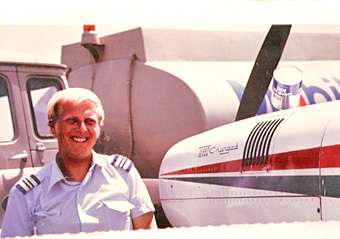
Stuart Darbyshire at Alice Springs in 1977
At the time, I was 23 years old, had only been operating for about nine months and didn’t have much outback flying experience but Trans West also had a Cessna 421 going on the Rally with a more experienced pilot flying for the Mercedes Team and he was going to give me some help. As it happened, the other aircraft was recalled from Alice Springs back to Perth so I was on my own from there.
The Fiat team arranged for a CB radio to be fitted to the aircraft so we could communicate with the rally cars as well as the back up vehicles. They also had an eight ton truck full of spares and several Land Cruisers.
About two days before the rally was due to leave Perth the team asked me to come to their hotel to discuss their plans. They asked me about the terrain and road conditions and I just “winged it” so they didn’t know I hadn’t been out there myself.
Gigi Farinetti (Fiat’s Rally Director not sure of the spelling) would point to some of the cattle stations on the map and ask if they could get Fiat parts there or fuel. Fuel maybe but they would have to bring everything else. I was amazed to see that their maps were Visual Aeronautical Charts which were provided by the organizers. I guess road maps were not available.
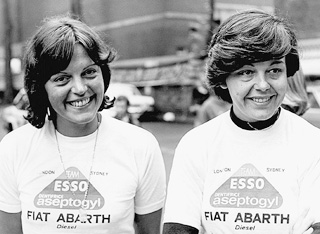
Yveline Vanoni and Christine Dacremont
The two French girls, Christine Dacremont and Yveline Vanoni had apparently decided not to fit a “Roo bar” to their vehicle as it upset the steering. I thought this was a mistake but they were adamant.
Naturally, on the first night they hit a kangaroo which damaged the front of their car. We caught up with them in Laverton WA and some repairs were carried out there.
From there the rally headed north towards Cosmo Newbury.
We gave the Italian crew a head start and then took off after them as Jack Lesage ( the photographer ) wanted to get some shots of them on the road. We saw a white car amid lots of dust so I did some low fly bys for the photos. I found out many years later that it was the wrong car!!! In an incredible co-incidence I had a passenger sitting next to me on a charter when the conversation turned to the Rally which he drove in. He said there was a low flying aircraft which scared the crap out of him and his co driver just north of Laverton. They were privateers driving a Holden (I think). Imagine his amazement when I confessed that it was me!!!
Everything went pretty well until after we turned north from Alice Springs.
We flew up to Wave Hill station and landed there hoping to catch up with the three cars but there was no sign. We then flew south and landed at Hooker Creek NT where two of our cars came through. They were the French crew of Robert Neyret and Marianne Hoepfner and the Italian crew of Carlo Baghetta and Carlotti (I don’t know why only one name). We waited for Christine and Yveline until it was almost dark but we had to go so took off south for Alice Springs. Just as we reached our cruising height of 10,000 feet we had a call on the CB radio from the girls saying they had an accident and they needed help. Apparently they were having more trouble with the radiator overheating and had turned back to meet up with the back up vehicle.
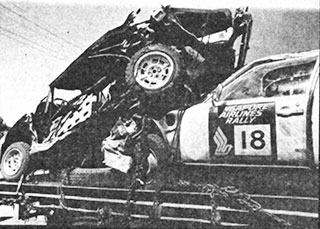
The cars - 18 is the Citroen and the wrecked Fiat
Unfortunately they had a head on collision with the very last Rally car on the road which was the Citroen team of Andre Stuckelberger and Bernard Cheneviere.
I radioed Flight Service for the Royal Flying Doctor Service (RFDS) aircraft to come and to their aid but was told that the airstrip nearby at Kalkgurung NT had no runway lights so the RFDS wouldn’t land there at night. I immediately turned our aircraft around and asked Flight Service to arrange fuel for me at Katherine NT as I intended to fly to Kalkgurung at first light and pick them up.
On the way to Katherine Gigi told me there were some English speaking voices on the CB radio and handed the microphone to me. It was a Police officer who told me that one of the girls was dying and needed immediate help.
I asked him to take her to Wave Hill station as it had a radio beacon and possibly had runway lighting. The officer said he considered that the road was too rough and the journey would certainly kill her.
I then asked him to go to the Kalkgurung strip and point his headlights into wind and I would see what I could do when we got there. By now it was pitch black and with complete cloud cover so I had no visibility with the ground. On the way there I told the guys on board what the situation was re the lack of runway lighting. I also had no strip diagram or elevation so I didn’t know how high we were above the ground. Things were a lot more primitive in those days and there was no central register of outback airstrips.
Charter pilots would quite often have very little information about the strip we were going to and we would get information over the phone or figure it out when we got there !!!!
I took a vote between us because I knew very well that a landing without lights was very dangerous but I wanted to give it a try. Gigi and Jack were all for it but the young mechanic sitting next to me was not at all keen. He was outvoted 3 to 1. I must admit I felt for him. He thought he was going to die.
When we arrived overhead I saw some lights on the ground which looked like a settlement or mining camp. There was a solitary pair of headlights a bit further on which I guessed must be the Police vehicle. I flew a timed circuit over the top and made an approach to land. Although the aircraft has a landing light all you get is a pool of light running over the ground at 160 kph. You can see very little. I thought we were too high so I did a go around and made another attempt. Of course as soon as I pulled the nose up to flare for landing the landing light became useless as it is pointing up into the air. Amazingly it was one of the best night landings I ever did.
The Almighty saved us that night !!!
I taxied over to where all the lights were and saw it was a group of cars. When I got out a woman came up to me and asked what did they do wrong ? I said “nothing you did as I asked”. She said “well we all have our headlights pointed down the main airstrip… you landed on the short one !!!” From the air there was no way I could have seen that. They had no idea how to arrange vehicles along the airstrip.
I pulled some of the seats out and a motorbike that Gigi had insisted that we carry from Perth and tied down the stretcher that Christine was on and put her fellow driver Yveline, (who was very badly bruised all over) as well as Gigi and Jack in with us. Needless to say the mechanic wasn’t coming !!!
The Police officer then asked where I was going to take them and I said to Alice Springs. He said no the best hospital is in Darwin, so that’s where I replanned to. I didn’t have enough fuel to get there so went via Katherine hoping the refueller was still there as we were very late having gone via Kalkgurung instead of straight there as originally planned. Unfortunately the HF radio that night had so much static that I could not get through to Flight Service so they didn’t know where we were. I tried every frequency I could think of but we just couldn’t make contact.
We arrived at Katherine and the airport lights were on !!! Thank God.
The refueller said he had to have his call out fee before giving us fuel. I told him we were on a Mercy Flight but he insisted so I threw $20.00 at him and got the fuel. I asked him to phone Flight Service and tell them where we were and that we were going to Darwin but I don’t think he did. On the way the conditions were very rough and I was very concerned the turbulence might kill Christine. But she was obviously very tough and survived.
Once we got within VHF radio range of Darwin Flight Service I told them what was happening and arranged an ambulance for our arrival. We got in around midnight.
As we were taxying in the Tower asked me to phone the SOC (Senior Officer in Charge).
I thought “Oh God my career is over“. So after we got the girls away to hospital I rang him and he asked me what the lights were like at Kalkgurung. I said “they could stand some improvement“ and luckily for me he left it at that.
Gigi and Jack went to the hospital and I for some very needed rest. I had been going since 7.00am that morning. Christine, as I recall, had a broken collarbone, arm, ribs and pelvis as well as internal injuries. The doctors said she would not have survived the night.
I am told she was in traction for six weeks and stayed in Darwin hospital for three months.
To this day I still don’t know if I did the right thing because I risked four lives to save one.
The following morning, at the hotel, a local news crew asked us if we had been involved in the rescue but I had sworn Gigi and Jack to secrecy as I was very concerned I could lose my pilot’s licence.
Of course, while we were heading north the rally was heading south and Gigi was desperate to catch up with it. I had made an arrangement with the Police the previous night that I would come back and pick up my seats and the two Citroen drivers who had been involved in the accident. We arrived over the top and I saw a small settlement which I proceed to “beat up”. (Fly low over the top). The aircraft is very noisy and you would have to be dead not to hear it. We landed and I put the seats back in but no sign of the cops. Gigi wanted to use the motorbike to go look for them but there were three roads into the airstrip and I didn’t know which one to use so I made him stay. In the end he insisted and off he went. Five minutes later the cops came in on another road so I asked them to chase after him and “...where does the road go anyway?”. “Nowhere” was the reply.
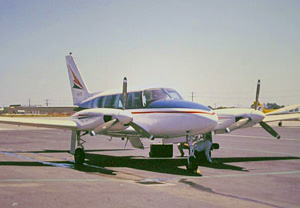
Piper Navajo VH-CFE
I made Gigi wait until the motor was cool before I loaded it back on and we took off.
The Citroen drivers were extremely pleased to leave. I don’t think they liked the native community much. I never saw the mechanic again!!! God knows what happened to him.
We finally caught up with our cars that night just north of the Adelaide SA hills. The rest of the trip was pretty uneventful with us doing the radio relays and crew changes for the back up drivers. I met up with my dad, briefly, at Essendon Airport Vic along the way.
Everything said on the CB radio was in French or Italian so I didn’t know what was going on and had to redo the flight plan many times. It sure sharpened my flight planning skills !!!
Fiat’s directors were so pleased with how it all went that they flew out from Italy for the finish and took me to a slap up meal in Sydney as well as the Opera House for the awards.
I took a couple of days off and flew back to Perth via one of the cattle stations to drop off one of the back up crew.
They wouldn’t let me keep the motor bike. Bugger !!!
Stuart Darbyshire
Chief Pilot Regent Air Services Ret.
August 2011
The Magenta: Rallying on shirt-buttons
Why build a plastic kit-car full of second-hand bits to take on the Longest Car Rally In History?
Philip Young discovers the cheapest way to go international rallying.
In the 70s British club-rally scene, garden-shed creations where sheer enthusiasm very obviously outweighed the cash investment were very familiar but nothing, absolutely nothing, had ever been so successful as the Magenta.
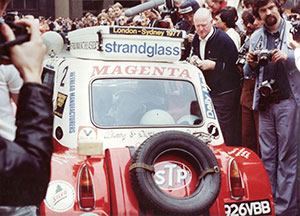
Second car away... crowds jostle round the Magenta at the 1977 London-Sydney Rally, Covent Garden start
A Magenta had taken the overall lead of the prestigious CCC national rally championship… and “Triple-C” was the monthly bible we all subscribed to – a motoring magazine devoted to Cars and Car Conversions, where half the pages were about readers involved in club motor-sport. Triple-C sponsored a national rally championship and, with monthly exposure in the magazine, all the clubs competed for the honour of staging a round. The top events attracted the top drivers. Do well on the CCC Championship, and you landed all sorts of offers of drives for the following year – it was part of the ladder of fame and on to even bigger things.
For Yorkshire farmer Alan Thurlow mixing it with the rich-kids was only possible if someone helped him sponsor a car – he didn’t have far to look, at the other end of the Dale lived his cousin, Steve Johnson, general guru and design boffin of Lightspeed Panels. Steve knocked out fibreglass cabinets for British Telecom to keep body and soul togethe, and provide a shilling for the gas-meter. At the same time he was designing cars in his disused railway shed workshop while living in the yard in a caravan that also acted as the Lightspeed sales-office.
BMC’s 1100 had been a top seller – there were lots of them, having grabbed an amazing 19 per cent total of the British car market but they were now rusting along just nicely for Steve’s purposes. Chop off the body, use the subframes (er, a bit of a problem there, as the subframes usually rusted the worst), keep the fantastic hydrolastic suspension, the brakes, wiring bits, and mount into a sort of beach-buggy-Mini-Moke type body fronted by an MG 1100/1300 traditional chrome grille, complete with authentic MG chrome slats. It was not about winning a beauty contest – here was a cheap runabout. It would never go rusty again.
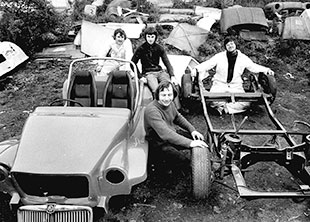
Magenta Builders: (rear) Steve Spencer, Ray Hudson and Will Richardson, with Steve Johnson, alongside the front of the London to Sydney chassis
And…. "it was never meant to be a rallycar", Steve used to say as he walked around his yard, sounding like Mini designer Alec Issigonis. Yet it took to the Yorkshire rallyscene by storm, particularly events put on by Whitby Car Club, and soon Thurlow was right up there, collecting trophies, mixing it with the overall winners. Traction was fantastic, the ride on bumpy “whites” phenomenal, and the cornering, now that the body was lightened by a third, was sensational. Not just Mini Coopers were outgunned, Thurlow was beating Escorts and Chevettes. Give it a 1275cc engine with a tad over 100 bhp, pulling along a body weighing little more than 10 cwt, and it was bound to be nippy. That’s 200 bhp per ton.
Having seen the 1968 London to Sydney Marathon leave London and vowing at the time that “if there is ever another, I’m not being left behind cheering from the pavement” there was no other way of getting into the second edition without going the kit-car route. Any other option would require serious dosh.
Certain design-limitations were always going to be problematic for a drive half way round the world – like 12 inch wheels (what local tyre dealer in Iran has seen one of those), hydrolastic suspension (has a roadside blacksmith in Pakistan ever seen suspension with no springs), then there’s the small push-rod engine lacking a five-speed box… not to mention a fibreglass body, all these “disadvantages” were ignored. Getting worked up about what other people were entering was not a topic that ever crossed our minds – come what may, we would be in Covent Garden with a car with competition door numbers on the side. Nobody else had a car as small as this, and everything else was mega-bucks in comparison.
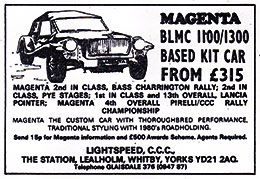
A Magenta ad proclaims a string of rally success
Lightspeed loved it – Steve was selling Magentas long after it was all over on the back of the London to Sydney, and even though his “works car” missed the boat out of Madras, he had gained enough street-cred with mentions in the Daily Mail and CCC-magazine to advertise themselves as the one kit-car “ tough enough to go rallying”… Steve sold 500 kits in total, and at one point was so busy churning out Magenta bodies that he had to give up making plastic boxes for British Telecom.
Steve took charge of the car build – promising a stronger body (thicker all round, but, alas, heavier), a few mods to the chassis, and that was it. Corbeau provided two seats; Lucas Competitions Department had it in their Birmingham workshop for ten days making a hand-made wiring loom; Richard Longman built an engine, for free, donated by Unipart; Minilite donated a dozen magnesium wheels; the Retread Manufacturers Association provided 20 re-tread tyres… and so, the cheapest rallycar by far took shape for the London to Sydney, change out of a grand. With my job on the News Desk at the Daily Mail, national newspaper column inches would be almost guaranteed, whatever the outcome.
More help came from a pre-war parts specialist by name of Barry Walker – he is still trading – who donated an ultra rare MG J4 petrol tank from a Brooklands racer. There were less than 10 J4s, so all no doubt raced at Brooklands. This was cut into the rear and gave a capacity of 16 gallons – Steve Johnson was reluctant to do this, as he reckoned it would upset his nicely-balanced chassis, and would be too exposed hanging on the back, and in this, he was probably right. Jack Knight donated a fantastic straight-cut gearbox, and the final drive was lowered, a crucial error there. Finishing off, Chris Bruce at Freeway Exhausts built the exhaust system, adapting a Hillman Hunter 1500 silencer box.
To get the car built on time, co-driver John Corner stepped it to lend a hand – and so came to know every nut and bolt around the car.
As a learning curve, this could not have been steeper.
It was the first time any kit-car had entered an international rally. Alan Thurlow, meanwhile, was proving a rally-Magenta wasn’t quite nuts – as the London to Sydney car took shape at the old railway station at Lealholm, near Whitby, he was out every weekend rallying – and ended up leading the CCC Championship. Into the final round, his car blew a gasket, and a differential-pin, the engine basically lunched itself. A crushing disappointment. But, still ended up second overall. Not a bad effort for a car that started life as a kit costing just £400. Thurlow was hailed the under-dog of the championship.
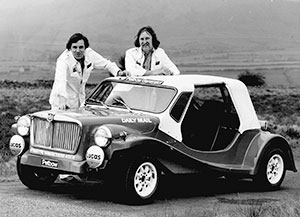
Philip Young and John Corner pose with the Magenta
As a result of the organisers start order ballot the Magenta was second car away from the Covent Garden start ahead of a phalanx of more sophisticated machinery. At Athens the Magenta was 2nd in class, and 51st overall, and we made it on time to the Tehran control. It was hanging on in there. There had been few issues apart from having a flat battery in Greece, caused when a last-minute fitment of a Fairy Liquid bottle, bolted in as an oil breather-pipe catch-tank, sprayed fine oil mist onto the fan belt on bumpy roads, causing the belt to slip, running the battery flat.
Good old George Harris in his Citroen Estate loaned us a battery in the middle of the night. John Corner made it fit the Magenta, even though it was twice the right size, and had square bolt on terminals, instead of push-on round ones. In the middle of a Greek olive grove at three in the morning, John joined up Citroen to BMC and got the Magenta moving again.
Disaster struck leaving Tehran – down a busy street-market, a woman crossing the road wearing the black shroud Burkha with yashmak across her face, simply walked into the back of the car. The Magenta was inching along at walking pace, weaving in and out of donkeys and market-traders. The woman was shocked, collapsed in a crumpled heap, but, once standing up and brushing herself down, did not appear to be injured. The mistake was for me to offer to take her to hospital for a check up. Later, in Bombay, Paddy Hopkirk was to point to a shoe wedged under his windscreen wiper….”I’ve driven through India with that stuck there… dunno how it got there,” he mused, shrugging his shoulders. In other words, had I kept going, cruel though it sounds in retrospect, things would certainly be very different...
After taking the unfortunate woman to hospital, I was arrested and spent the next couple of days behind bars while papers were prepared for a court hearing – all written out in Farsi and to be heard in Arabic.
There was little I could do, or say, except, in the cell next door was a Turkish girl accused of living off immoral earnings who spoke fluent English, and helped, through the bars, with translations. She chatted away and so lifted depressed spirits, so, too, did the Police Chief, in his own way…when he said he had a brother who ran a restaurant in Eastbourne, I quickly took the hint… “Ah, I know it well,” I said. Actually, I couldn’t recall when I last set foot in Eastbourne, but when you are locked up in Iran, and all your mates have left town, you’ll cling to anything. He introduced me to my first-ever dish of Chicken Dhansak – which isn’t Indian, but Persian… so, with a decent curry, and a prostitute to talk to, Tehran’s down-town nick wasn’t quite as bad as it sounds. I certainly had it better than the prison cell of Ian Baxter and Mike Ellis who were to go behind bars in Pakistan, and the Peugeot crew of Brian Hilton and Barry Lake, who were thrown into a prison cell after an accident back in Turkey.
The Magenta lives on
The Magenta survives in remarkably original state, and has been in my garage for the past five years. After shipping back from Bombay, Lightspeed took over ownership of the car. I recently sold it to Paul Stephens, who plans to restore the car and use it in historic rallies… if that happens, it will be the only car from the ’77 London to Sydney still rallying, no mean achievement for a car that started life as a £400 do-it-yourself kit.
PY
Just before the court hearing, I had a visitor at the police station – it was former Australian rally-champion Ken Tubman. After the rally left Teheran, Ken, who was waiting for a flight to India, became rally official turned prison visitor. He brought with him a young lad from the hotel – still in his Bell Captain’s uniform – to act as interpreter. “There will be questions about all this in the British parliament on Tuesday,” said Ken, to the police chief, who just shrugged, and then asked the lad something that must have been along the lines of “what’s that got to do with me?” sort of thing. “Oh, I don’t know…” said Ken, shaking his hands as he made for the door, “...if you lock up a British journalist from a national newspaper, you can bet the Prime Minister and Foreign Secretary might be making a statement to Parliament, and talking to your President...” and then said goodbye, asking the Bell Captain to pass on his remarks in Persian. He spun round and walked down the steps to the courtyard outside.
Hours later, I was greeting the Bell Captain, having been given a ride in a police car back to the Intercontinental Hotel, clutching a piece of paper that was supposedly a fulsome apology from the Magistrate – and the Police Chief.
John Corner took the car on, single-handed, and turned in a remarkable drive of sheer determination and tenacity, and got the car to central-India. He then flew into Madras, having been told the boat was about to leave, only to learn as he stepped off the plane that the boat had in fact been held up for three days. That was just about the final straw. The Mini Clubman crew of Mike Dickin and Simon Park had gallantly helped him, to the detriment of their own results, and the two cars had driven in tandem across Afghanistan, Pakistan and India (read Simon Park’s book, featured on the Rally Bulletin section of this site).
While John was slaving away across deserts and mountains, I was trying to get out of Tehran, and play catch up.
Philip Young
May 2009

Number one in a series of Daily Mail "Marathon Motorists" strips featured the Magenta
Excess Baggage
One of the problems Martin and Sue Clark had to cope with as “flying marshals” in Van, western Turkey, was to help sort the paperwork following the accident involving the Peugeot 504 Estate of Australian Peugeot Team members Dave Bradford and Gill Davis. Gill's leg was broken in the crash and it did require resetting when he reached Bombay on his way home to Australia. Apart from that this version differs somewhat from the account recorded in John Stathatos' book 'The Long Drive', but Martin remembers the events quite clearly.
Martin recalls:
“They had collided head on with a local who died instantly. However, when I went to the Van police station, I found Gill sitting by the reception desk with his leg up on a chair – freshly plastered – playing cards with the guards. He had rescued some tins of beer from the back of the Peugeot, which he was sharing with the policemen.
It turned out that the man who died was a local thug who had given the police regular problems, and they were actually quite pleased with the fact he would no longer be around.
Gill was going back home to Australia, via India. But Dave had problems. Peugeot had loaned him a special engine, and they wanted it back. However, the rally had crossed into Turkey without all the documentation normally experienced by single travellers. The cars had just been waved through en-bloc, so now taking an engine out of the country was impossible because there was no paperwork to show how it had come in.
We had a few days holiday after the rally left Van but came across Dave again at Ankara airport and caught up with the rest of the story.
Dave had found the only way out of the country with the engine was to go back to the border where they had entered from Greece, hand over 400 cigarettes, get his passport stamped with the car details entered, so it could now be cancelled out by the customs officials at Ankara. By the time we met him at the airport he had succeeded in getting the engine removed from the wreck, crated up, and delivered to Ankara but he was pretty miserable about the enormous hassle with Turkish bureaucracy. The engine was going into the hold of a passenger plane as 'excess baggage' and in doing so the operation had cleaned out their remaining rally budget.”
May 2009
Meet Jim Gavin
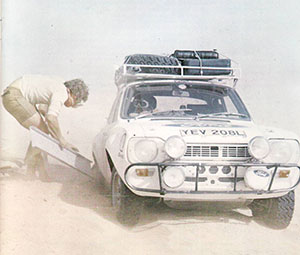
Jim Gavin stays in the car during a Sahara sand storm on the '74 World Cup route survey.
When we called Jim, we were asked if we could call back in five minutes as right now he was on a stake-out at the bathroom window with his Webley aiming to shoot the grey-squirrel that had been robbing grub from the bird-table.
Irishman Jim Gavin was the acting Clerk of the Course on the ’77 London-Sydney Rally, although that title was initially denied him, and the event began without a Clerk of the Course. This was to change when the rally reached India where Jim’s job was expected to end at Madras. Like the rally doctor, Dr. John Teall, Jim had not been paid to be with the event after Madras and had been given a ticket to fly back to London.
Wylton's plan was that the Confederation of Australian Motor Sports team would take over running the rally after Madras but they insisted that Jim should stay and what is more he should be promoted to Clerk of the Course. Jim wasn’t going anywhere without being paid, and just one more of the hassles Wylton Dickson had to cope with was getting a bank-draft raised back in England and sent to Jim’s cottage in Sussex.
Jim was Wylton’s first appointment coming to the job early on (see Jim gets the Job). The sponsorship from Singapore Airlines was not in the bank, but Wylton was convinced he was going to nail this, so invited Jim to be the “Secretariat” and put the show on the road.
Jim’s background in motorsport had been an involvement in club rallying, and racing – he had been the official “Rally Competitions Manager” for the UK importers of Moskvich, who wanted to increase their brand awareness in motorsport and liked the idea of entering the British Rally Championship as the class structure was based on the showroom price of the cars, and no other car with a 1500cc engine was a cheap as the Russian car.
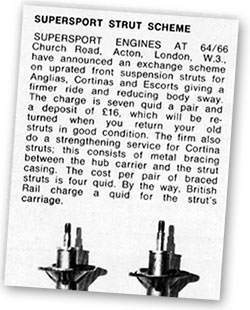
Triple-C magazine announces the 'Jim Gavin' Supersport struts
Other highlights in Jim’s career came during his time as a partner in the Acton based Supersport Engines tuning firm. Jim had formed the company at the end of 1965 with Rod Cooper, ex of Lawrencetune, and Terry Hobson. At Supersport Jim reckons he invented the technique of “wedging” Ford front struts to prevent them from bending under rally conditions... a job that required some steel tube of the correct size to reinforce the strut base. At about this time the local newspaper reported the mysterious disappearance of steel support poles from the newly installed experimental parking meters on Acton High Street. When asked by the reporter why anyone would cut down parking meters and leave the money-box mechanism on the pavement the local police chief scratched his head and said: “Well, it’s rather Irish to me.” Little did he realise that in the hunt for the villain he had just ignored his own clue.
Another distinguishing hallmark in his rise to fame was that while working at Supersport, Jim worked on the cylinder heads of Triumph’s TR engines that were then despatched to the Morgan factory for the all-new Morgan Super Sport engine, an attempt by Morgan at the time to cash in on their remarkable success in winning the two-litre class at Le Mans in the hands of Chris Lawrence. Most of these heads were modified after lunch, and Jim now reckons that the amount of metal ground away after a visit to the local pub was such that the performance of the Morgan Supersports must have been grossly inferior to the standard Plus Four model.
In 1968, Jim had good contacts with Ford, and was able to use his influence to obtain more than one “body-in-white” (bare bodyshell) and a pre-production Escort. He then set about producing the first ever international Ford Escort rallycar, and certainly the first Escort to ever go rallying with a 1600cc cross flow Ford Cortina engine shoe-horned under the bonnet. This hybrid “GT” was two years before Ford were to do the very same thing for their works team on the London to Mexico World Cup Rally, which proved so successful Ford then produced 1600cc models badged as “Mexicos”. Jim regrets that he never patented the idea. Read the Article
His crew in the three-up Escort included the son of Reggie Maudling, then the Conservative Government’s Chancellor of the Exchequer.
In 1970, Jim became a roving marshal on the London to Mexico, and saw from the inside, how long distance rallies could be made to work. As the junior member of the team, and therefore deemed the most expendable, he was given the job of flying in light aircraft and landing at remote airstrips high in the Andes – and then legging it to even remoter spots to run time-controls.
In 1974, Jim was asked by Wylton to help run the first ever rally to cross the Sahara – the 1974 World Cup Rally that would go to Nigeria, and then return for a second Sahara crossing to finish in Munich (see our history chapter). The rally was notable for nearly causing Stirling Moss to lose his life after officially being declared lost in the dunes, and, almost fell apart, organisationally, in the bottom of the Sahara when many other crews took a crucial wrong turning.
For the 1977 London-Sydney Rally Jim was to be Uncle to all of the competitors, a sort of combined Competitor Relations Officer, Rally Secretary, and Clerk of the Course combined, and was seen as very much the front desk, or face of the Organisation. Everyone’s problems, frustrations, and let-downs eventually came to Uncle Jim, who had a soothing, calming way with a large band of disparate characters who all wanted one thing out of him…. to charge half way round the world, against the clock, with a chance of being rated as a finisher for the party at the end of it all.
Jim has written four motor sport related books: "Club Motor Racing", Batsford, '77 - "The Ford Escort and Rallye Sport", Pelham Books, '73 - "Ford Cortina, Tuning for Power and Performance" with Stuart Turner, Arlington Books, '72, and "Rallying Escorts and Cortinas", Haynes.
After the '77 London-Sydney was over, Jim was asked to explore other ideas for long distance rallies that sprang from the fertile mind of Wylton Dickson, but nothing came of them. Instead, he turned ideas of his own into reality, “alternative, true grass-roots motorsport", founding the wacky world of lawn mower racing and the Wisborough Green 12-hour endurance mower race. It’s been televised and reported on world-wide. Five times Le Mans winner Derek Bell and Stirling Moss, who Jim rescued from the Sahara in 1974, are among past winners.
Today, Jim still lives with his wife, Mary, in the same wisteria-covered cottage at Wisborough Green, where he first started work on the London to Sydney. He's been known to drive around the village in a frog-eye Sprite, and still appears as a Marshal on the odd Historic Rally, having been involved in the ground-floor of the historic-rally movement.
He prefers to start the day with a visit to the bathroom – carrying an air-rifle – where he refuses to be interrupted.
April 2009
Jim Gavin is Offered the Job
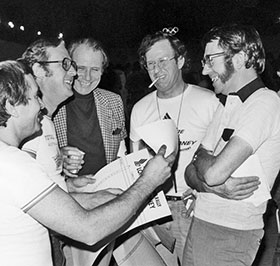
(right to left) Jim Gavin jokes with rally officials Stewart McLeod and Peter Cooper, plus Citroen CX2400 crew Patrick Vanson and Jean-Paul Luc
Jim Gavin recalls how he was employed to take on organising the 1977 London-Sydney Rally.
“Wylton came down to Sussex, sat in the kitchen, and offered me £7,500 if I would take on the job.” recalls Gavin. “It was the first and only time he came to my house... I said yes, and we shook hands.”
Jim would be given the job of Rally Secretary, in fact even now his actual job title is somewhat vague – the longest rally in history would run without an official Clerk of the Course listed in its Regulations.
Jim quietly began his planning. A little too quietly, as two months later he opened a newspaper to read that former Australian rally champion Ken Tubman was driving overland from London to Sydney.
“I shot up to London, confronted Wylton with the paper, and asked what the hell was going on! He replied that as not much had happened in the previous two months, I could keep the job, but with two months less wages, so the fee would now be £5,000, and, that Tubman had to drive the route to prove to Singapore Airlines that it could be done, and so help land the sponsor. With a deep breath, we shook hands again.”
The money, nor the relationship, however, would ever be quite the same again.
Paddy Hopkirk
Paddy Hopkirk still feels strongly about the way the 1977 London to Sydney Marathon was run, as evident in his comments in a biography written recently by Bill Price (published by Haynes).
On page 185, the book reads:
In New South Wales, a 100km error in the route instructions from Menindee to Warrigate became the subject of more controversy. The instructions said: ‘In 27 kms T-junction – turn left’ when it should have read `127 kms turn left’. Peter O’Gorman, navigating the Tony Fowkes Mercedes, spotted the error and radioed his team-mates, but lost time on this very rough section which had many closed gates. Hopkirk's navigator, Bob Riley, did not spot the error, but with his local knowledge navigated Paddy along a more or less parallel road, arriving at Warrigate losing only one minute. The Organisers scrubbed the section when the route-note error was highlighted. A protest from the Citroen team against the cancellation of penalties on this section was perhaps unsurprisingly rejected, as Andrew Cowan recalls:
“We followed the route instructions, but Bob Riley, who knew the area, took Paddy on the road on the other side of the river. We lost time because the control was closed and the marshals had left by the time we arrived. As Paddy had been about the same amount of minutes behind us, he was now in the lead. However, we protested, and the section was cancelled, partly because of the mistake in the road book but mainly because the control was closed. The Citroen team protested, but the result was not changed,” recalls Andrew.
The book goes on:
So the Cowan Mercedes – backed up by a superb support team – retained the lead. Typical of the thoroughness of the German effort, Mercedes had Unimog 4x4 trucks at hand in the Australian desert, to pull their cars if they became stuck. “Yes, I suppose it was cheating,” says Paddy. “But we used one of the Unimogs ourselves. I think we bribed the driver. Mercedes had gone through, and we got a bit stuck, so we bribed the guy to get us out. So we weren’t going to protest the trucks.”
There was more controversy at the Durikai control. The start marshal retained the road book of Tony Fowkes, but Tony’s co-driver, Peter O’Gorman, assumed it would be returned at the finish control which was close to the start control. On arrival at the finish control the road book was not there, so Mercedes Team Manager Eric Waxenburger set off down the road to retrieve the roadbook from the start control. When he turned up with the missing document, Tony was able to continue, but with no delay allowance offered. However, they made up enough time on the next section to avoid a penalty.
The Citroen team protested about this incident and the stewards imposed a 30 minute penalty, but this did not effect the overall positions. Despite all the problems, the Total Citroen Australian Team won the team prize and Paddy, Michael Taylor and Bob Riley were placed third overall in the General Classification.
Page 187 of the book is headed: Enough is Enough
“There seemed to be an awful lot of arguments with the organisers on the rally,” says Paddy. “For three days after the finish, crews and the Organisers argued over the results, while we recovered."
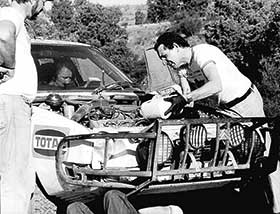
Hopkirk pours oil into the Citroen
Exhausted or not after the experience, Michael Taylor reckons today that he picked the right driver: “I’d done the first London to Sydney marathon with Innes Ireland, and the London-Sahara Rally (1974 World Cup Rally) alongside Stirling Moss. They couldn’t hold a candle to Paddy off-road, and his ability to conserve the car was magical. I can’t say enough about his skills!”
But if the rally had been a memorable event, Paddy was glad it was over, as he told the Belfast Telegraph: “It was lovely when it stopped. You can take it that I have definitely retired now. I never want to drive in another rally again.”
Today, he continues to believe that the organisation left a lot to be desired. “There were gaping loopholes in the regulations. Most of the trouble centred around the Mercedes team. On the stage to Brisbane I dropped one minute, but Cowan and Fowkes were over on hour behind. That put me in the lead, but they accused me of taking a short cut. The Germans were very manipulative at getting that section taken out.”
The Citroen CX Gti, built at Brisbane by 1974 World Cup winner Jim Reddiex, still survives, and still carries the large Hopkirk rallyplate logo across a black bonnet.
Paddy recalls running out of oil after splitting the sump, and Michael Taylor stopping at a remote farmstead in a wild part of Australia, with no other way out that to undo the sump plugs of two vehicles, and 'borrow' the oil. As a way of warning what they had done, the sump plugs were left on the bonnets of the two vehicles…in the hope that the owner would return and wouldn’t just jump in and try driving off. This problem caused Paddy to drop 31 minutes on this section behind Tony Fowkes. At another service point, the rallycar’s sump plug itself was lost…fortunately, a spectator’s car was near to hand and his was borrowed. Paddy Hopkirk’s book doesn’t record how the spectator got home.
April 2009
A Control Point in Turkey
It was down to the crews to find the time controls, often with sketchy information – front runners had the advantage that crowds would simply point the way. Travelling marshals didn’t carry any boards, signs, or arrows, that was supposed to be provided by local motor-clubs, or, just considered to be unnecessary.
For example, Martin and Sue Clark were down to run the control at Van, reached by flying to eastern Turkey, and hiring a car. When they found the hotel nominated for the time-control and where they were to stay for 24 hours, Martin, who had got the job after he had doggedly volunteered to paint oil drums with luminous paint all the way across the Sahara to Tamanrasset on the 1974 World Cup Rally, now realised that the Van hotel was nothing more than a “brothel for homosexuals”. He had expected the flea-pit that it certainly was, but the constant flow of young rent-boys going up and down the stairs was something he didn’t think Sue should put up with, so he pinned a note to the door of the hotel saying the control was moved.
He didn’t say where it was moved to – he didn’t know where he would end up, just that it was moved. He also knew it was unlikely the note would last for long. As it happened, the alternative site was set up at a petrol station on the outskirts of town, and finding the Van control proved easier for crews than many other places.
April 2009
The Luck of the Irish
Jim Gavin’s route planning enjoyed the “luck of the Irish” on more than one occasion.
The first was an out of the blue call from Iskender Arouba, a motor-sport enthusiast in Istanbul, who called up to say he was coming to London to buy a car and drive it back to Turkey. While in the UK Iskender thought he'd be interested to hear about the planning for the rally as his motor-club would like to help when it hit Turkey.
“Ah, good man,” said Jim, “you will be wanting someone to help navigate you back home... I’m your man.” With that, Iskender found himself driving the route plan for the London to Sydney as far as Istanbul, and with his newly gained inside knowledge, he couldn’t resist entering the rally. There was considerable interest in Turkey so the main car producer would have to enter a car.... at a stroke Jim got a route survey provided for him, and, another entry.
The second degree of “assistance” came when Mike Broad called the rally office to introduce himself as navigator and general office-planner for the Andrew Cowan Mercedes entry. “I’m thinking of going off to Iran to drive the timed section from Yazd to Tabas”. Broad was going to fly to Tehran, hire a car, and drive across the Great Salt Desert to make notes.
“Excellent,” said Jim. “when you get back, perhaps you can drop by so I can compare your notes with mine.” Broad duly did so. Gavin copied furiously... he hadn’t got any notes, nothing, not even an idea where to site the start and finish controls – things like bumps and washaways in between didn’t matter to him. “What time did you think the Merc would do it in?" asked Jim, tentatively... "oh, well, anyone who does it in four hours will be really flying," said Broad.
“Ah, thought so,” said Jim, sucking on his pencil. It then dawned on Mike Broad that what he had in fact done was rather more than just recce the route, he had also driven a route survey for the Organisation. When the Time Cards booklet was eventually printed, it simply stated: “ Yazd to Tabas: Distance 410kms, Time allowed: 3 hrs.” Everyone was late, including Cowan.
April 2009
Gavin to the Rescue
Jim Gavin was in Tamanrasset in the south of Algeria during the 1974 World Cup Rally at the time when several cars were not accounted for. Jim had given his word to competitors that he would not abandon them and was now having a long distance argument with rally director and friend Henry Liddon who want him to leave Tamanrasset by plane. Jim refused.
This passage from Evan Green's book "A Boot Full of Right Arms" takes up the story..
Jim Gavin was in a troubled state of mind as he left Tamanrasset. He had clashed with his friend Henry Liddon, he had argued with the Algerians and he had been forced to spend a great deal of money on what he hoped would be a wasted mission. Additionally, he himself now had to face the unpleasant prospect of a slow drive through the Sahara at the onset of summer. But any doubts of the wisdom of his stand vanished as the two Land-Rovers approached the remains of Fort Serouenout.
It was two o'clock in the afternoon of the third day since the rally cars had set out on their long journey to the north. Gavin's party had seen no signs of life since leaving the settlement of Hirhafok and he was now sweeping the route towards the refuelling point at Fort Gardel, still 168 km away.
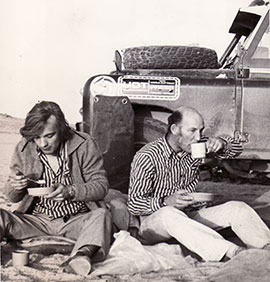
Allan Sell and Stirling Moss take welcome food & drink after Jim Gavin's 1974 Sahara rescue.
Fort Serouenout was a tiny relic from the Foreign Legion days of French colonisation. No more than a square of crumbling mud and stone, it stood out only by the symmetry of its design in a region of vast plains and worn hills.
Parked in front of the fort was a white car. And lying against one of the decaying walls, their bodies dappled by its shade, were three men.
Stirling Moss, Michael Taylor and Allan Sell had been there for two days. It would be an exaggeration to say they were near death, but not that they were in a desperate situation. The three men - who had given away five gallons of water at Tamanrasset - drank the last of their supply as the rescue vehicles drove into view. Allan Sell was unconscious. All were severely affected by the heat and the overwhelming loneliness of their location.
Their Mercedes-Benz 280E, already severely battered by the journey to Tamanrasset, had broken its shock absorbers through the Hoggar Mountains. The shaking had loosened the plates within the battery.
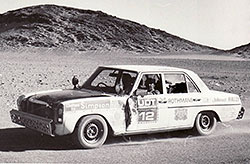
The battered Mercedes of Moss, Taylor and Sell on the 1974 UDT World Cup Rally
They had been stuck in sand several times. Each experience had been terrifying, for had the motor stalled while they dug they had no means of restarting. Believing they were the last car on the road added to their worry. Waiting for rescue on a sandhill had no appeal, so they halted when they reached the fort.
It was built on firm ground, where they could restart the car by pushing it in gear. They could have gone farther, but would almost certainly have bogged or broken down at some less hospitable place where their chances of survival were poorer.
Besides, they took some comfort from the fact that men had once lived here. A building, even an abandoned one, offered a sense of security in this inhuman land.
So they stopped at Fort Serouenout and waited for Jim Gavin. They knew he would come because he said he would.
.....
"I got to the point where I was getting twitchy," Moss admitted later.
"They say a drowning man sees his life all over again. Well I think it must be true. I was lying there thinking about what I'd done and thinking of the futility of it all."
"Most of all I felt regret. I was so sorry I'd been such a shit to all my friends."
April 2009
The Afghan Interior Minister
One of the "extras" drafted in to stiffen the secretariat in Gerald Road was freelance motoring hack Tony Howard. In this blog article Tony recalls an encounter with Wylton Dickson at Gerald Road.
THE AFGHAN INTERIOR MINISTER: Returning to Britain after some years abroad, I was engaged by cigar-chomping Wylton Dickson to help run his Singapore Airlines London-Sydney Rally. First I called at his headquarters, in Noël Coward's very theatrical former home in Gerald Road, Belgravia. I found Wylton with a small group of well-wishers I had never met before. As much to their surprise as to mine, he spontaneously began to interview me on the spot.
Nothing ventured, I thought. After about 20 minutes, he turned to the others, saying: "He'll do, don't you think?" They could hardly contradict him in front of me, and pretty soon I was in the thick of things. One of my assignments was to smooth competitors' progress across Afghanistan, where an overnight road curfew was imposed by locking the barriers at the frequent checkpoints.
My contact was the Afghan interior minister, whom I could only reach via a very crackly short-wave radio telephone circuit, open from London for two hours on Tuesday and Thursday mornings. Shouting at the top of my voice to be heard in distant Kabul, I asked the minister to have the barriers unlocked for us. His barely audible reply was: "Yes we can do that if you send us 75,000 dollars US." "He says he wants 75,000 bucks," I called across the room to Wylton.
"Tell him to f**k off," came the curt response from behind a cloud of Havana smoke. Mind racing to re-phrase this more diplomatically, I put the receiver back to my ear, only to find the line had gone dead. Saved by the bell, I had 48 hours to come up with a negotiating ploy.
Copyright © by Anthony Howard http://www.wordspix.co.uk/
April 2009
